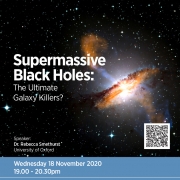Wednesday 18th November at 7.00 pm on MS Teams, Caroline Herschel Prize Lecture, Supermassive Black Holes – the Ultimate Galaxy Killers?
Image credit: ESO/WFI (Optical); MPIfR/ESO/APEX/A.Weiss et al. (Submillimetre); NASA/CXC/CfA/R.Kraft et al. (X-ray)
The talk is being run by the University of Bath in conjunction with the Herschel Society and the Royal Astronomical Society.
There are over one billion galaxies in the Universe, each home to over a billion stars and one central supermassive black hole weighing in at up to a billion times the mass of the Sun. Theoretical astrophysicists think that these supermassive black holes can either heat or remove the cold hydrogen gas within a galaxy needed to form new stars through a huge outburst of energy. This process has to occur in computer simulated universes to stop galaxies evolving and growing too large. However, the big problem is that astronomers have never actually observed this process happening in our Universe.
This talk will focus on the research of astrophysicists trying to understand the conflict between observations of galaxies and their supermassive black holes and the current best model of the Universe. In particular Dr. Smethurst will highlight the work being done by the MaNGA survey team who are attempting to map the insides of over 10,000 galaxies in order to solve this long-standing problem.
Dr Becky Smethurst is an astrophysics research fellow at Christ Church at the University of Oxford working with the innovative data provided by the SDSS MaNGA survey to determine the effects of supermassive black holes on their host galaxies. She was awarded her PhD by the University of Oxford, using the public’s classifications of the shapes of galaxies from the online citizen science project Galaxy Zoo in her thesis on galaxy evolution. She then had a research fellowship at the University of Nottingham where she also started presenting videos for the science YouTube channels Sixty Symbols and Deep Sky Objects.
A slightly edited recording of this lecture is available on the following link.

 ESO/WFI (Optical); MPIfR/ESO/APEX/A.Weiss et al. (Submillimetre); NASA/CXC/CfA/R.Kraft et al. (X-ray)
ESO/WFI (Optical); MPIfR/ESO/APEX/A.Weiss et al. (Submillimetre); NASA/CXC/CfA/R.Kraft et al. (X-ray)